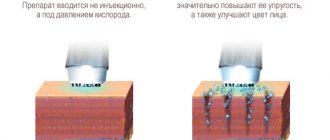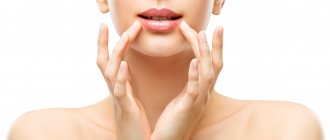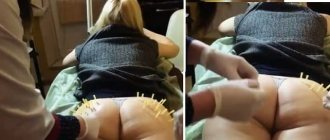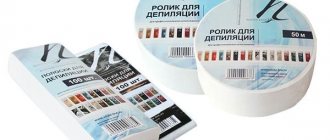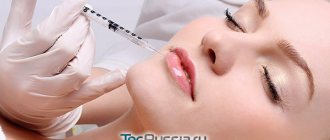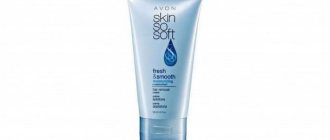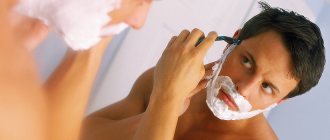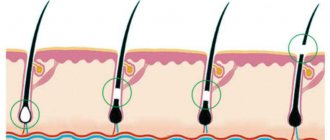Read in this article:
- Why does hair grow ingrown?
- Ingrown hairs after sugaring
- What do ingrown hairs look like?
- Prevention of ingrown hairs after hair removal and depilation
- Folk remedies for ingrown hairs
- How to get rid of ingrown hair using pharmaceutical products?
- Epilation without ingrown hairs
The problem of ingrown hairs is familiar to many girls, and most often it occurs after removing excess hair on the body at home. Salon procedures rarely give a similar effect, but still, performing hair removal or depilation at home is much more profitable financially, as well as in terms of comfort and time saving. The solution is obvious: you need to understand all the intricacies of the procedure and take measures to prevent ingrown hairs.
Why does hair grow ingrown?
Ingrown hairs in the bikini area or on the legs are a consequence of improper implementation of the hair removal procedure or violation of its technology. The hair is not removed, but breaks, and over time begins to grow directly under the skin. In this case, it becomes deformed due to damage to the bulb or due to the inability to break through the thick layer of skin.
Experts explain why hair grows on the legs for several reasons:
- Thick epidermis;
- Genetic predisposition;
- Hormonal imbalance, for example, increased production of estrogen;
- Formation of scars inside the hair canal after hair removal;
- Curling of hair below the level of the epidermis;
- Shave against the direction of hair growth, especially when using the razor repeatedly.
Ingrown hairs on the legs, in the armpit area, and in the bikini area can appear due to wearing uncomfortable synthetic underwear. This material prevents the evaporation of moisture from the skin and provokes a bacterial infection. That is why it is not recommended to wear such underwear immediately after hair removal.
The appearance of this problem is largely due to the density of the epidermal layer. If there are a large number of dead cells on the surface of the skin, it becomes too rough. The growing hair cannot break out, so it bends and grows horizontally.
Useful tips
- It is not recommended to carry out hair removal on critical days, or in a bad mood. During this period, irritability and absent-mindedness increase, which can affect the quality of the procedure.
- It is better to remove vegetation before going to bed. Wounds left after depilation or shaving are especially susceptible to infection in the first hours. But by going straight to bed, the risk of infection will significantly decrease. During sleep, the skin is restored and cells are regenerated. The possibility of the appearance of inflammatory processes and pustules is reduced.
- When choosing a cream for ingrown hairs, you must pay attention to which area it is intended for. Foot cream may cause irritation in the bikini area. You need to carefully read the composition and instructions.
- Wear synthetic underwear as little as possible. Bedding should also be made from natural fabrics.
- When showering, you should use a hard washcloth.
- After epilation, you should not wear rough or synthetic clothing or nylon tights.
- If you have frequent ingrown hairs, it is not recommended to use a greasy cream.
Now we know the “enemy” by sight. Remembering the causes of ingrown hairs and regularly taking preventive measures, you will soon forget about the problem for a long time and enjoy the beauty and smoothness of your legs.
Ingrown hairs after sugaring
Similar situations happen with different methods of depilation, but one of the most common questions is why hair grows on the legs after sugaring. This is a popular procedure, but ingrown hairs after it are not uncommon. This happens for several reasons:
- In case of incorrect or insufficient skin tension during paste removal;
- In case of violations of the technology for applying the composition and tearing off;
- When using low-quality materials;
- When trying to get by with a minimal amount of paste;
- When removing short hairs.
By understanding why hair grows in after sugaring, you can avoid many mistakes. It is enough to buy a high-quality paste, apply and remove it correctly. And if you don’t have the necessary skills yet, it’s better to go to a salon or use another method of removing unwanted hair.
Is it necessary to give up hair removal if you can’t cope with ingrown hairs?
If the fight against ingrown hairs after sugaring, waxing or just a razor has become an unbearable problem, you don’t have to be hairy at all! Pay attention to laser or photoepilation.
Laser hair removal significantly reduces the likelihood of ingrown hairs, since it has a different effect on the hair: the laser does not pull it out, but causes the follicle to die with a light beam. As a result, the hair falls out on its own.
As an additional advantage, laser hair removal using a cooling gel does not damage the skin, and the procedure itself is painless and as sterile as possible in a cosmetology office.
Since hair growth slows down after laser exposure, and growing hairs become thinner, a second laser hair removal session will be required no earlier than a month later, and with subsequent procedures this period will increase.
Eliminating regular damage to the skin and hair roots when pulling out will speed up the treatment of previously ingrown hairs and eliminate relapses.
What do ingrown hairs look like?
It is very important to detect ingrown hairs after epilator in time in order to take timely measures and prevent negative consequences. You can talk about ingrown hairs if:
- Small round bumps (papules) appear on the skin;
- Pustules filled with serous or purulent contents form;
- Severe itching and painful sensations appear;
- The skin becomes red and inflamed.
With such manifestations, suppuration may well begin. The danger increases due to the fact that the skin is very itchy, so there is a risk of injury and infection.
Tests and diagnostics
If pseudofolliculitis occurs regularly, you should visit a dermatologist. The doctor determines ingrown hairs visually by external signs. But in some cases, a specialist needs to exclude the presence of other pathologies. Therefore, he may order additional examinations.
Dermatoscopy is an instrumental examination that allows you to examine areas of the skin in multiple depths. In this case, manual optics or an automatic dermatoscope are used. This examination makes it possible to assess the condition of the skin and determine the specific signs of pseudofolliculitis.
Laboratory analysis of the contents of the abscess - this examination is relevant if the abscess constantly develops in one area. This study allows you to determine the causative agent of the infection.
During the diagnostic process, it is important to exclude a number of diseases: pyoderma , folliculitis , hyperkeratosis , acne .
Prevention of ingrown hairs after hair removal and depilation
However, not all hair removal methods provoke ingrown hairs. For example, after laser hair removal, hair rarely grows back, since the essence of the method is to destroy the hair follicle without damaging the skin. The same applies to photoepilation.
Both methods allow you to remove already ingrown hairs that are located under the skin. This effect is achieved by exposure to a laser or light pulse. But these options are relevant only in the absence of inflammation and suppuration. Accordingly, replacing waxing, sugaring or shaving with one of these procedures will already be a good prevention of ingrown hairs.
Some other actions will help get rid of this problem:
- Shortly before hair removal, you should do a light peeling or scrubbing. This procedure will remove dead skin cells of the epidermis, which become one of the causes of ingrown hairs;
- Peeling will not hurt after hair removal; ideally, it should be done several times over several days after hair removal;
- Women who use a razor should direct it along the hair growth, and not against it;
- After epilation or depilation, regardless of the method chosen, it is worth applying a hair growth inhibitor or moisturizer to the skin.
If hair grows in the bikini area, there is a possibility that hair removal is carried out too often, and the hairs do not have time to grow back. The procedure should be carried out no more than 1-2 times a week, and for sensitive skin an even longer interval is required. It is better to forget about dry shaving forever - this is the most effective way to injure the upper layer of the epidermis and cause ingrown hairs.
Prevention
To prevent such problems, you should remember the following rules of prevention:
- Choose the right hair removal method. It's better to leave this to the professionals. If you remove it yourself, you should definitely carry out a procedure to soften and exfoliate the skin. The razor for removal should be sharp, and depilatory creams should be of high quality. You should not use shaving machines for a long time: this increases the likelihood of ingrown hairs.
- Shave hair in the direction it grows. When shaving, you should use foam or other special products.
- Use special lotions and creams after hair removal.
- Do not wear synthetic underwear after hair removal.
- Observe all rules of personal hygiene.
Folk remedies for ingrown hairs
Each girl chooses for herself how to deal with ingrown hairs. Laser hair removal is considered one of the most effective methods. But you can also use folk remedies for ingrown hairs:
- A compress of aspirin tablets dissolved in warm water is applied for half an hour;
- Applying toothpaste to the ingrown hair, which dries the skin and has a disinfectant effect on the follicle;
- Treating the skin with olive oil and then scrubbing with coffee grounds;
- Steam the problem area until the ingrown hair is visible. Then it can be removed using tweezers.
A loofah washcloth also has a scrubbing effect. Regular use of such an accessory during water procedures will help remove the layer of dead skin cells, soften the skin, and help the hair come out.
Symptoms
Hair can periodically grow in any place where unwanted hairs are periodically removed by some means. Most often, this phenomenon is observed on the legs, armpits, pubic area, neck and cheeks in men.
The main early signs of ingrown hair are the development of swelling and hyperemia. After some time, the development of the inflammatory process is noted. papules appear at the sites of ingrowth , which hurt and itch. In some cases, the tip of the hair may be visible through the skin. However, if a person tries to pull it out on their own with tweezers or another instrument, then an infection may end up getting inside the follicle. This leads to the formation of microabscesses. When the inflammatory process subsides, scars or pigmentation remain in its place.
Sometimes ingrown hairs come out on their own.
How to get rid of ingrown hair using pharmaceutical products?
Another way to get rid of ingrown hairs is to use pharmaceutical products. Suitable for this purpose:
- Salicylic acid - it must be applied pointwise to provide an antiseptic and exfoliating effect;
- Levomekol ointment – relieves inflammation and softens the skin;
- Zinc ointment – fights inflammation, helps eliminate pigment spots that appear at the site of ingrown hair;
- Glycolic acid – reduces the thickness of the stratum corneum and facilitates the process of hair growth outward;
- Ichthyol ointment - after treating the problem area with this product, wrap it in polyethylene, leave it overnight, wash off the ointment in the morning and apply a nourishing cream. Usually, it takes several such procedures to remove an ingrown hair.
Under no circumstances should a needle be used to remove ingrown hair without first disinfecting it. This is fraught with infection getting under the skin and further inflammation. You should not try to squeeze out a hair like a pimple: such an impact will lead to the movement of serous contents or pus directly into the skin.
If a pustule with pus has formed in the bikini area or on another part of the body, or inflammation has appeared, it is best to go to the clinic for hair removal. In such a situation, the surgeon opens the abscess, sanitizes the wound and carefully eliminates the ingrown hair, and then treats it with an antiseptic.
What not to do?
When inflammation occurs, it is forbidden to treat the damaged area with a scrub, remove skin, or squeeze pus out of the pustule like a pimple. Also, you should not try to squeeze out an ingrown hair or bulb. Strong impact on the diseased area can lead to the formation of a dark pigment spot that does not go away over time and cell damage.
It is not recommended to remove ulcers yourself. Firstly, non-sterile instruments are used for cleaning. Secondly, pus may remain in the cavity. As a result, a new, stronger one may form in place of the old inflammation. At the same time, the skin becomes rougher, which complicates the treatment process.
The use of non-sterile materials and instruments may cause infection of the wound.
Reasons for the problem
To understand why a nail grows, it is important to understand how it works. Human nail plates “begin” in the matrix, which is located at the base of the nail. Its visible part is a white crescent-shaped area. Nails grow as the germ cells divide and gradually the old nail plate moves forward.
The growth rate of nails is 0.1 mm per 24 hours. Accordingly, the nail completely changes in 100-105 days. The nail plate has a convex shape, due to which it partially dampens the mechanical impact on the leg, and partially transmits it to the soft tissues of the side roller with which it comes into contact.
The side rollers “cushion” the nail. If they are damaged, the protective functions of the nail are impaired.
Why do toenails grow ingrown?
There are several reasons:
- Improper care of the nail plate. If the corners of the nail are cut into an oval shape, too deep, it grows incorrectly and can grow into the tissue of the periungual fold.
- Wearing tight shoes with a narrow toe - constant pressure on the nail provokes ingrowth and inflammation.
- Fungal and bacterial infections.
- Congenital foot deformities - for example, wide first toe and hand syndrome (Rubinstein-Taybi) and Ostler syndrome.
- Prolonged compression of the foot with a fixing bandage, for example, a plaster.
- Foot injuries.
- Anatomical features of the structure of the fingers and feet - for example, large periungual ridges.
- Acquired bone deformities - flat feet, etc.
- Some diseases: collagenosis, gout, rheumatoid arthritis, diabetes.
- Pregnancy and sudden increase in body weight.
Prevention: how to prevent ingrown toenails
There are ways, and quite simple ones. If you are healthy, there are no pathological processes in the body that can lead to ingrown nails (that is, for example, you do not have fungal diseases, etc.), it is enough to follow 2 rules:
- Choose comfortable shoes - ones that do not put pressure on your big toe or little toe.
- Trim your nails correctly - without rounding the corners and leaving at least 1 mm of the nail plate, do not cut at the root.
Comfortable shoes should not interfere with the free growth of the nail. That is, it should not be too tight, putting pressure on the forefoot and nails. It is better to give preference to models without heels, with elastic and not completely flat soles. If you cannot give up dress shoes completely, wear them only in exceptional cases. And not for too long.
For hallux valgus (when the first toe deviates inward relative to the others), it is important to use silicone inserts. If you have flat feet, do not forget about special insoles or orthopedic shoes.
The correct technique for cutting nails is very simple: it is important to trim the nail in a straight line using straight nail scissors. File the corners with a file so that they do not injure the skin.
A timely medical pedicure is another way to monitor the health of your feet and nails. A visit to a podiatrist and a hygienic pedicure allows you to eliminate all problems at the initial stage, enjoy an easy gait and beautiful nails without signs of pathology.

